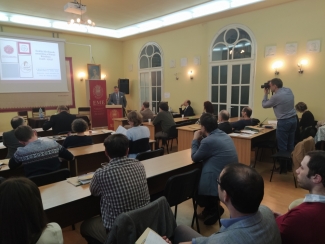
The members of the Fraknói Research Group presented their Vatican-related research on Transylvania in a separate section at the event titled "Hungarian Science Day in Transylvania 2023," upon the invitation of the Transylvanian Museum Association on November 18. In the headquarters of the Transylvanian Museum Association, four members of the Research Group held their presentations under the chairmanship of Zsolt Bogdándi.
In his presentation titled "Vatican Hungarian Historical Research and Transylvania," Péter Tusor reviewed the Monumenta Vaticana Hungariae, the Fraknói Institute, and the subsequent period of institutional interregnum. He highlighted the Transylvanian aspects of significant publications and emphasized that the systematic collection of Vatican materials was originally conceived by Ignác Batthyány, the Transylvanian bishop. In the concluding part of his presentation, he illustrated the development of the CVH and the Fraknói Research Group, emphasized works related to Transylvanian history, and outlined research perspectives concerning Transylvania at the Vatican.
Tamás Fedeles provided a synthesis of entries concerning the consecration of Transylvanian clerics in the series of Libri formatarum located in the Vatican Secret Archive's Camera Apostolica collection in his presentation titled "Consecration of Transylvanian Clerics in the Roman Curia (1426–1523)." By expanding this source material with other sources and embedding it into an international context, he portrayed a nuanced picture of the late medieval Roman consecrations of Transylvanian clerics. He drew attention to the fact that despite the distance from Rome, nearly as many individuals from Transylvania traveled to the Eternal City as from the geographically closer diocese of Zagreb.
Viktor Kanász presented the mid-16th-century connections between Transylvania and the Holy See's diplomacy through the activities of nuncios. He highlighted that contrary to popular belief, Rome paid serious attention to the Kingdom of Hungary. Nuncios assigned to King Ferdinand I dealt not only with religious affairs but also focused on events related to anti-Ottoman wars. In the early 1550s, significant attention was given to the fate of the eastern region, the later Principality of Transylvania, Fráter György's attempt at national unification, and the assassination of the Bishop of Várad. The latter part of his presentation delved into the creation of Cardinal Fráter György, outlining Ferdinand I's efforts in this direction. Although Fráter couldn’t perform any activities as a cardinal due to his death, he can still be regarded as the last Hungarian cardinal of the Crown until the 18th century.
Titled "A Brief Yet Decisive Period in the History of the Principality of Transylvania," Tamás Kruppa's presentation introduced new perspectives by emphasizing the significant role of personalities in shaping events, especially the activities of VIII. Kelemen in the holy war against the Ottomans. Kruppa highlighted, based on new research findings, the previously unknown fact that the papal troops dispatched to the Hungarian theater of war in 1595 were originally intended to be stationed entirely in Transylvania. Another key point was that the failures of the fifteen-year war significantly contributed to the formation of the later political doctrine of the Principality of Transylvania. This doctrine primarily aimed to maintain the alliance with the Ottoman Empire, leading Transylvania to abstain from participating in the end-of-century liberation wars, resulting in its exclusion from Ottoman influence.
The written versions of the presentations will be published in the 12th volume of the Certamen series.
